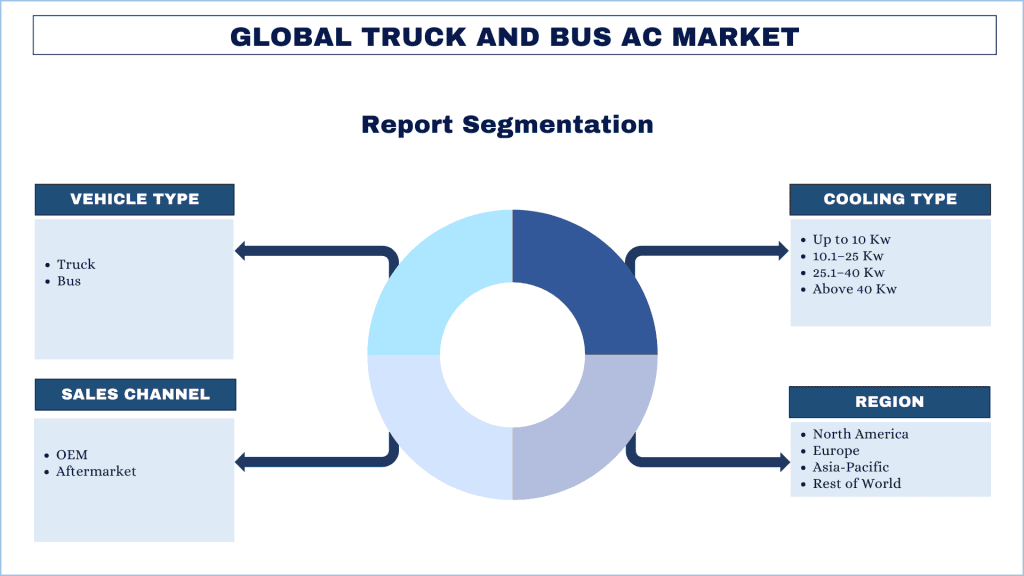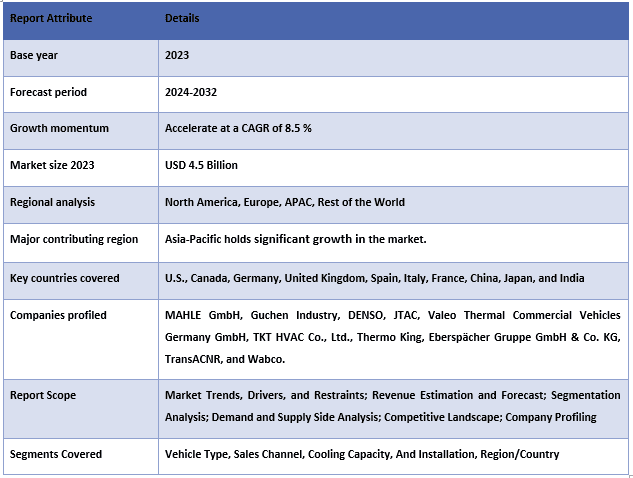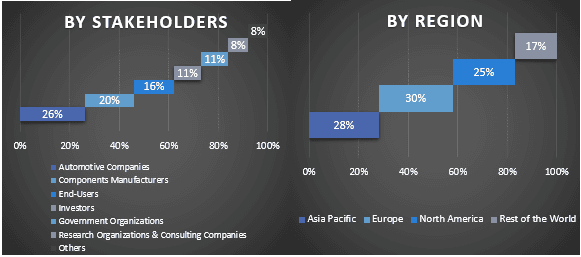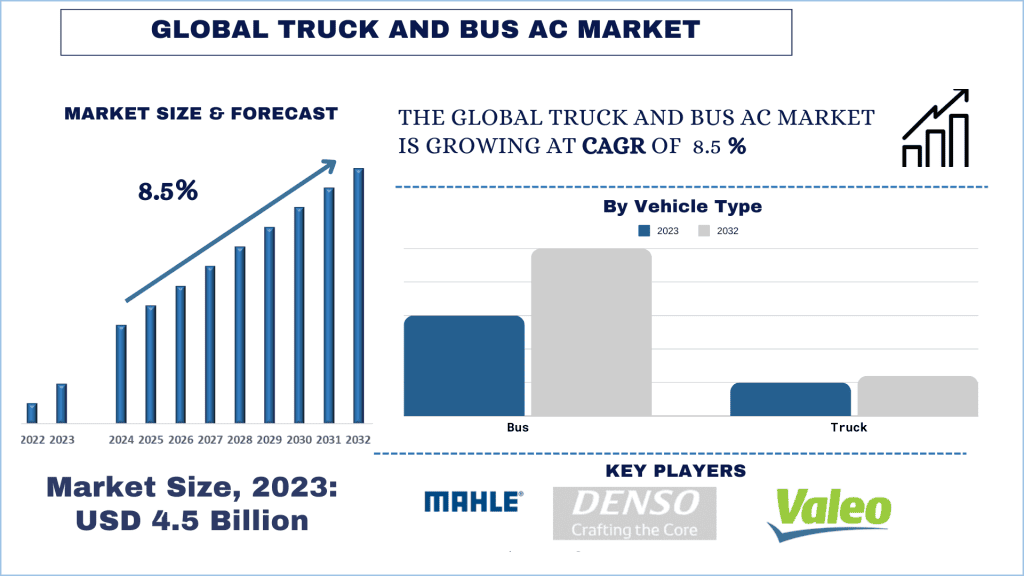- Inicio
- Acerca de nosotros
- Industria
- Servicios
- Leyendo
- Contáctenos
Mercado de AC para Camiones y Autobuses: Análisis Actual y Pronóstico (2024-2032)
Énfasis en el Tipo de Vehículo (Camión y Autobús), Canal de Ventas (OEM y Posventa), Capacidad de Refrigeración (Hasta 10 Kw, 10.1–25 Kw, 25.1–40 Kw y Más de 40 Kw), Instalación (Montado en Pared, Montado en Techo y Montado en Pared Trasera), y Región/País.
Tamaño y Pronóstico del Mercado de AC para Camiones y Autobuses
El mercado de AC para Camiones y Autobuses se valoró en USD 4.5 mil millones en 2023 y se espera que crezca a una sólida Tasa de Crecimiento Anual Compuesta (CAGR) de alrededor del 8.5 % durante el período de pronóstico (2024-2032).
Análisis del Mercado de AC para Camiones y Autobuses
El mercado de AC para Camiones y Autobuses también está siendo moldeado por el rápido ritmo de los avances tecnológicos. Los fabricantes están incorporando características de vanguardia, como controles avanzados, compresores de bajo consumo energético y telemática integrada, para mejorar el rendimiento y la eficiencia de sus sistemas HVAC. A pesar de las perspectivas de crecimiento, el mercado de aire acondicionado para camiones y autobuses enfrenta varios desafíos, incluidos los altos costos iniciales, la infraestructura limitada y la creciente competencia de las soluciones de transporte alternativas.
Sin embargo, estos desafíos también presentan oportunidades para la innovación y el crecimiento. Se espera que el desarrollo de sistemas de aire acondicionado más eficientes y rentables, combinado con el avance de la tecnología y el cambio de las preferencias de los consumidores, impulse el mercado en los próximos años.

Tendencias del Mercado de AC para Camiones y Autobuses
El mercado global de AC para Camiones y Autobuses está experimentando un crecimiento sin precedentes, impulsado por la creciente demanda de confort y la creciente demanda de comercio electrónico. Las tendencias emergentes se explican a continuación:
Electrificación y Sostenibilidad:A medida que los vehículos comerciales eléctricos e híbridos se han adaptado debido a las crecientes preocupaciones ambientales, también ha surgido la necesidad de sistemas HVAC que se interconecten eficazmente con estos sistemas de propulsión emergentes.
Sistemas HVAC Inteligentes y Conectados:Actuando como un grado adicional de libertad, IoT y el análisis de datos permitieron la introducción de sistemas HVAC inteligentes que mejoran la eficiencia energética y el nivel de confort, y generan información de servicio importante para los operadores de flotas.
Personalización y Personalización:Se ha identificado que los datos demográficos de los clientes juegan un papel crucial en la determinación de las necesidades específicas de HVAC en la región de Asia-Pacífico, como la configuración de la temperatura, la calidad del aire y los niveles de ruido, lo que continúa impulsando la competencia y el avance del mercado de sistemas HVAC.

Se espera que Asia Pacífico crezca con una CAGR significativa durante el período de pronóstico.
La región de Asia-Pacífico ha sido testigo de un crecimiento sin precedentes en su industria automotriz, impulsado por factores como el aumento de los ingresos disponibles, la urbanización y una creciente clase media. Esta expansión ha alimentado la demanda de vehículos comerciales, incluidos camiones y autobuses, lo que a su vez ha impulsado la demanda de sistemas HVAC avanzados para brindar un confort y una eficiencia óptimos a los conductores y pasajeros.
Descripción General de la Industria de AC para Camiones y Autobuses
El mercado de AC para Camiones y Autobuses es competitivo y fragmentado, con varios actores del mercado global e internacional. Los actores clave están adoptando diferentes estrategias de crecimiento para mejorar su presencia en el mercado, como asociaciones, acuerdos, colaboraciones, lanzamientos de nuevos productos, expansiones geográficas y fusiones y adquisiciones. Algunos de los principales actores que operan en el mercado son MAHLE GmbH, Guchen Industry, DENSO, JTAC, Valeo Thermal Commercial Vehicles Germany GmbH, TKT HVAC Co., Ltd., Thermo King, Eberspächer Gruppe GmbH & Co. KG, TransACNR y Wabco.
Noticias del Mercado de AC para Camiones y Autobuses
- En diciembre de 2023, el Ministerio de Transporte por Carretera e Autopistas emitió una notificación que exige que todos los camiones nuevos fabricados a partir del 1 de octubre de 2025 estén equipados con cabinas con aire acondicionado para los conductores.
Cobertura del Informe del Mercado de AC para Camiones y Autobuses

Razones para comprar este informe:
- El estudio incluye el dimensionamiento del mercado y el análisis de pronóstico validados por expertos clave de la industria autenticados.
- El informe revisa brevemente el rendimiento general de la industria de un vistazo.
- El informe cubre un análisis en profundidad de pares de la industria prominentes con un enfoque principal en las finanzas comerciales clave, las carteras de productos, las estrategias de expansión y los desarrollos recientes.
- Examen detallado de los impulsores, restricciones, tendencias clave y oportunidades que prevalecen en la industria.
- El estudio cubre exhaustivamente el mercado en diferentes segmentos.
- Análisis a nivel regional en profundidad de la industria.
Opciones de Personalización:
El mercado global de AC para Camiones y Autobuses se puede personalizar aún más según el requisito o cualquier otro segmento del mercado. Además de esto, UMI entiende que puede tener sus propias necesidades comerciales, por lo tanto, no dude en conectarse con nosotros para obtener un informe que se adapte completamente a sus necesidades.
Tabla de contenido
Metodología de Investigación para el Análisis del Mercado de AC para Camiones y Autobuses (2024-2032)
El análisis del mercado histórico, la estimación del mercado actual y el pronóstico del mercado futuro del mercado global de AC para Camiones y Autobuses fueron los tres pasos principales realizados para crear y analizar la adopción de AC para camiones y autobuses en las principales regiones a nivel mundial. Se realizó una extensa investigación secundaria para recopilar los números históricos del mercado y estimar el tamaño actual del mercado. En segundo lugar, para validar estas ideas, se tomaron en consideración numerosos hallazgos y suposiciones. Además, también se realizaron exhaustivas entrevistas primarias con expertos de la industria en toda la cadena de valor del mercado global de AC para Camiones y Autobuses. Después de la suposición y la validación de los números del mercado a través de entrevistas primarias, empleamos un enfoque de arriba hacia abajo/de abajo hacia arriba para pronosticar el tamaño completo del mercado. Posteriormente, se adoptaron métodos de desglose del mercado y triangulación de datos para estimar y analizar el tamaño del mercado de los segmentos y subsegmentos de la industria. La metodología detallada se explica a continuación:
Análisis del Tamaño Histórico del Mercado
Paso 1: Estudio Profundo de Fuentes Secundarias:
Se realizó un estudio secundario detallado para obtener el tamaño histórico del mercado del mercado de AC para Camiones y Autobuses a través de fuentes internas de la empresa, como informes anuales y estados financieros, presentaciones de rendimiento, comunicados de prensa, etc., y fuentes externas, incluidos revistas, noticias y artículos, publicaciones gubernamentales, publicaciones de la competencia, informes del sector, bases de datos de terceros,y otras publicaciones creíbles.
Paso 2: Segmentación del Mercado:
Después de obtener el tamaño histórico del mercado del mercado de AC para Camiones y Autobuses, realizamos un análisis secundario detallado para recopilar información histórica del mercado y compartirla para diferentes segmentos y subsegmentos para las principales regiones. Los principales segmentos se incluyen en el informe como tipo de vehículo, canal de ventas, capacidad de refrigeración e instalación. Además, se realizaron análisis a nivel de país para evaluar la adopción general de modelos de prueba en esa región.
Paso 3: Análisis de Factores:
Después de adquirir el tamaño histórico del mercado de diferentes segmentos y subsegmentos, realizamos un análisis de factores detallado para estimar el tamaño actual del mercado del mercado de AC para Camiones y Autobuses. Además, realizamos análisis de factores utilizando variables dependientes e independientes, como el tipo de vehículo, el canal de ventas, la capacidad de refrigeración y la instalación del mercado de AC para Camiones y Autobuses. Se realizó un análisis exhaustivo de los escenarios de la demanda y la oferta, considerando las principales asociaciones, fusiones y adquisiciones, la expansión comercial y los lanzamientos de productos en el sector del mercado global de AC para Camiones y Autobuses.
Estimación y Pronóstico del Tamaño Actual del Mercado
Dimensionamiento del Mercado Actual:Basado en información práctica de los 3 pasos anteriores, llegamos al tamaño actual del mercado, a los actores clave en el mercado global de AC para Camiones y Autobuses y a las cuotas de mercado de los segmentos. Todas las divisiones de cuotas porcentuales requeridas y los desglose del mercado se determinaron utilizando el enfoque secundario mencionado anteriormente y se verificaron a través de entrevistas primarias.
Estimación y Pronóstico:Para la estimación y el pronóstico del mercado, se asignaron ponderaciones a diferentes factores, incluidos los impulsores y las tendencias, las restricciones y las oportunidades disponibles para las partes interesadas. Después de analizar estos factores, se aplicaron técnicas de pronóstico relevantes, es decir, el enfoque de arriba hacia abajo/de abajo hacia arriba, para llegar al pronóstico del mercado para 2032 para diferentes segmentos y subsegmentos en los principales mercados a nivel mundial. La metodología de investigación adoptada para estimar el tamaño del mercado abarca:
- El tamaño del mercado de la industria, en términos de ingresos (USD) y la tasa de adopción del mercado de AC para Camiones y Autobuses en los principales mercados a nivel nacional.
- Todas las cuotas porcentuales, divisiones y desgloses de los segmentos y subsegmentos del mercado
- Actores clave en el mercado global de CA para camiones y autobuses en términos de productos ofrecidos. Además, las estrategias de crecimiento adoptadas por estos actores para competir en el mercado de rápido crecimiento.
Validación del tamaño y la cuota de mercado
Investigación primaria:Se realizaron entrevistas en profundidad con los líderes de opinión clave (KOL, por sus siglas en inglés), incluidos los ejecutivos de alto nivel (CXO/VP, Jefe de Ventas, Jefe de Marketing, Jefe de Operaciones, Jefe Regional, Jefe de País, etc.) en las principales regiones. Los hallazgos de la investigación primaria se resumieron y se realizó un análisis estadístico para probar la hipótesis establecida. Las entradas de la investigación primaria se consolidaron con los hallazgos secundarios, convirtiendo así la información en información procesable.
División de los participantes primarios en diferentes regiones

Ingeniería de mercado
La técnica de triangulación de datos se empleó para completar la estimación general del mercado y para llegar a números estadísticos precisos para cada segmento y subsegmento del mercado global de CA para camiones y autobuses. Los datos se dividieron en varios segmentos y subsegmentos después de estudiar varios parámetros y tendencias en el tipo de vehículo, el canal de ventas, la capacidad de refrigeración y la instalación del mercado global de CA para camiones y autobuses.
El objetivo principal del estudio de mercado global de CA para camiones y autobuses
Las tendencias actuales y futuras del mercado global de CA para camiones y autobuses se identificaron en el estudio. Los inversores pueden obtener información estratégica para basar su discreción para las inversiones en el análisis cualitativo y cuantitativo realizado en el estudio. Las tendencias actuales y futuras del mercado determinaron el atractivo general del mercado a nivel regional, proporcionando una plataforma para que el participante industrial explote el mercado sin explotar para beneficiarse de una ventaja de primer movimiento. Otros objetivos cuantitativos de los estudios incluyen:
- Analizar el tamaño actual y previsto del mercado de CA para camiones y autobuses en términos de valor (USD) y el tamaño actual y previsto del mercado de diferentes segmentos y subsegmentos.
- Los segmentos en el estudio incluyen áreas del tipo de vehículo, el canal de ventas, la capacidad de refrigeración y la instalación.
- Definir y analizar el marco regulatorio para el CA de camiones y autobuses
- Analizar la cadena de valor involucrada con la presencia de varios intermediarios, junto con el análisis del comportamiento de los clientes y competidores de la industria.
- Analizar el tamaño actual y previsto del mercado de CA para camiones y autobuses para la región principal.
- Los principales países de las regiones estudiadas en el informe incluyen Asia Pacífico, Europa, América del Norte y el resto del mundo
- Perfiles de empresas del mercado de CA para camiones y autobuses y las estrategias de crecimiento adoptadas por los actores del mercado para mantenerse en el mercado de rápido crecimiento.
- Análisis en profundidad a nivel regional de la industria.
Preguntas frecuentes Preguntas frecuentes
¿P1: ¿Cuál es el tamaño actual del mercado y el potencial de crecimiento del mercado de AC para camiones y autobuses?
¿P2: ¿Cuáles son los factores impulsores del crecimiento del mercado de AC para camiones y autobuses?
¿P3: ¿Qué segmento tiene la mayor cuota de mercado de AC para camiones y autobuses por tipo de vehículo?
¿P4: ¿Cuáles son las tecnologías y tendencias emergentes en el mercado de AC para camiones y autobuses?
¿P5: ¿Qué región dominará el mercado de AC para camiones y autobuses?
Relacionados Informes
Los clientes que compraron este artículo también compraron











